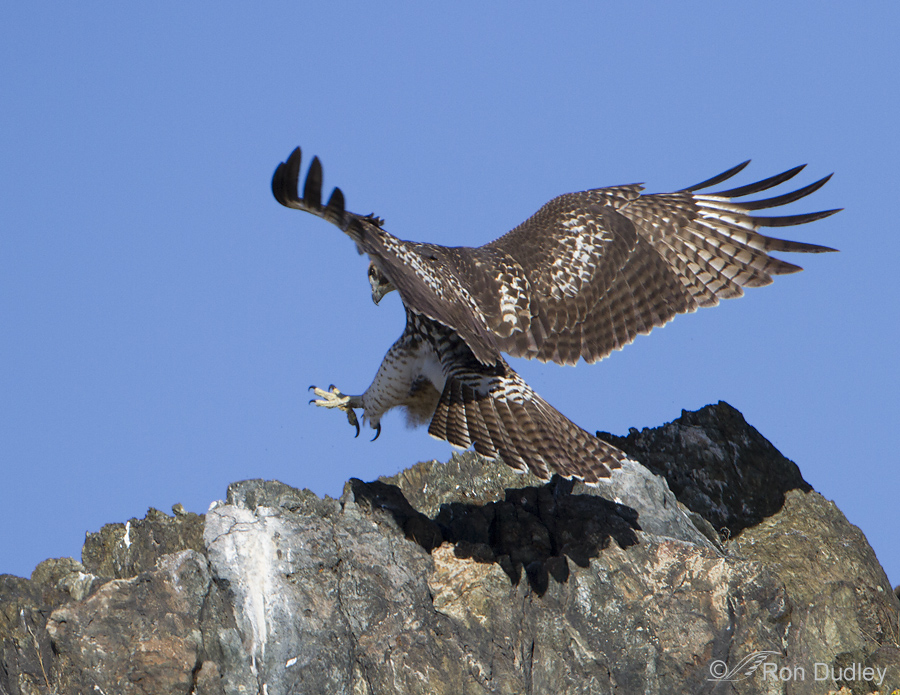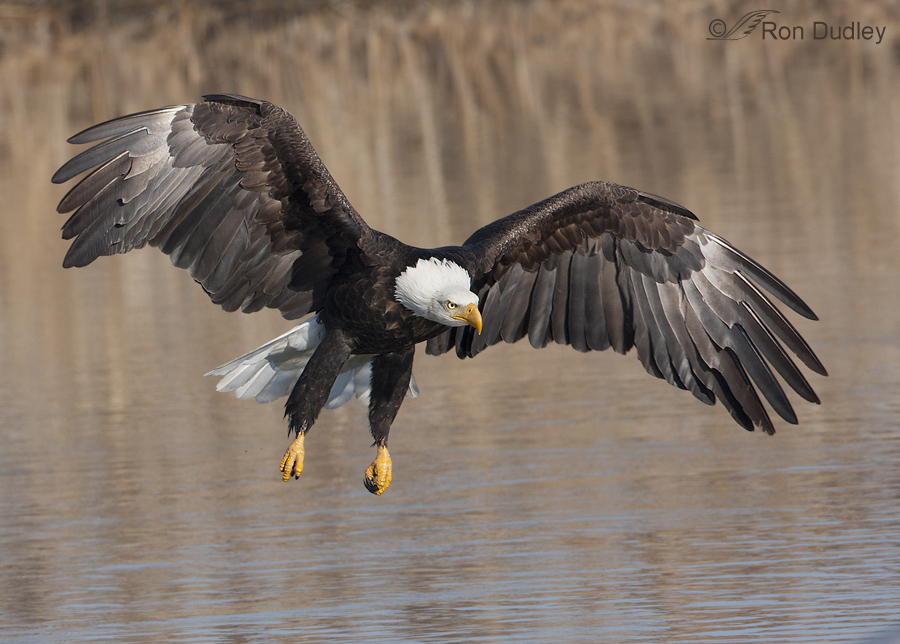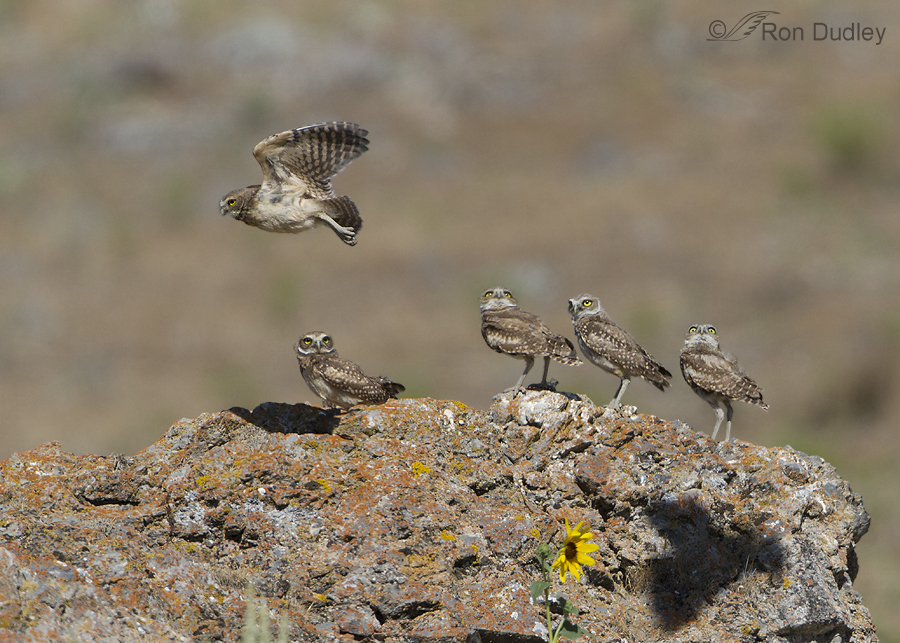Tag: landing
Intensity – Bald Eagle Landing For A Fight
Juvenile Burrowing Owls Practicing Take-offs And Landings
Landing Red-tailed Hawk
I haven’t often succeeded in photographing a landing raptor. When they take off they usually don’t come back and when they do it’s often difficult to maintain focus on them as they land because of close backgrounds. However, this immature Red-tailed Hawk gave me just such an opportunity a couple of days ago. 1/2000, f 7.1, ISO 500, 500 f/4 It was hunting from a huge rock outcropping and looking down over the valley in the background of this image. I spent quite a while with this bird but it was side lit and I wasn’t very optimistic about getting a decent take-off shot because I expected it to spot potential prey in the valley below and take off away from me, giving me butt shots only. 1/1600, f 7.1, ISO 500, 500 f/4 Which is exactly what happened. However, I saw where the bird landed far below in the valley, missed the prey and took off again so I wondered if I could be lucky enough for it to return to the same perch. I wasn’t particularly optimistic because I was so close to the rock (you’ll notice from my techs that I had even removed my tc). The problem was that as soon as the hawk took off from that distant perch it disappeared behind the same massive rock outcropping on the side of the mountain that had been its perch and if it did return I wouldn’t know it until the very last split second, as it flared up to land on the rock from behind and below it. So I prefocussed on the likely…
Goofy Red-tailed Hawk
When I first encountered this juvenile Red-tailed Hawk in Beaverhead County three weeks ago it was eating a vole on top of this fence post. Soon after it finished the rodent it began to act a little strange. 1/2000, f/6.3, ISO 640, 500 f/4 In these first few shots it may look like the hawk is simply shaking or “ruffling” its feathers but I’m convinced that wasn’t the case. I’ve seen many birds perform that feather maintenance activity but what was happening here looked quite different. I remember telling Mia while it was occurring that it looked like the bird was “dancing” on top of the post. 1/2000, f/6.3, ISO 640, 500 f/4 The hawk went through some strange gyrations and postures that were different from what you see with a simple “shake” and they lasted an unusually long time (I have many shots of the behavior). This tail-up posture, for example, is reminiscent of defecation but the bird didn’t defecate and the wing position isn’t what you would normally see during defecation anyway. 1/2000, f/6.3, ISO 640, 500 f/4 The bird wasn’t shaking to get these unusual feather positions either – instead it seemed to be deliberately and relatively slowly (compared to shaking) erecting its feathers. I have 8 – 10 shots that are very similar to this one and they’re not all in sequence. 1/1600, f/6.3, ISO 640, 500 f/4 Then the bird decided to take off from the post… 1/2000, f/6.3, ISO 640, 500 f/4 but…
Landing Juvenile Burrowing Owl
We had some more fun with the family of Burrowing Owls this morning. There are two adults and at least seven chicks. Some of the youngsters have been banded, which may be good for the owls but it isn’t particularly good for photography so I was happy to see that this one wasn’t wearing any jewelry. 1/2000, f/6.3, ISO 640, 500 f/4 One of the adult birds spent much of the morning perched on sagebrush to the left of this one and occasionally one of the youngsters would come in and land close by. I was pleasantly surprised by the eye contact in this image. Usually they’re looking down at this point in the landing process but I think a slight headwind gave this bird time enough to glance up at my pickup just to make sure we continued to be no threat. In the very next frame the owl was beginning to look down at its landing spot on the sage. I love the very early morning light on these owls but especially on the juveniles. The tradeoff is that ISO 640 is pushing it for my Canon 7D but I always like to have good shutter speed when an opportunity like this suddenly appears. I had taken off my tc but still barely fit the owl in the frame. The upper background is a distant sandbar and sloping shoreline of the Great Salt Lake. 1/1600, f/6.3, ISO 640, 500 f/4 I was able to get five sharp shots as this owl was coming in. My favorite of the sequence is the first image…
Just A Shot That I Like… #11, Bald Eagle In A Dramatic Flight Posture
It’s getting to be that time of year again – Bald Eagle time in Utah! As is typical for this season their numbers in the state are increasing every day. Eagle populations in Utah peak in January and February before many of them start heading north again. 1/1000, f/8, ISO 500, 500 f/4 Though it appears as if this bird was about to snag a fish from the water surface in reality it was simply coming in for a landing on the shore, just out of frame to the lower right. I like the light on the eagle and the overall flight posture. I’m looking forward to freezing my butt off again this winter while photographing these very impressive birds. Ron




